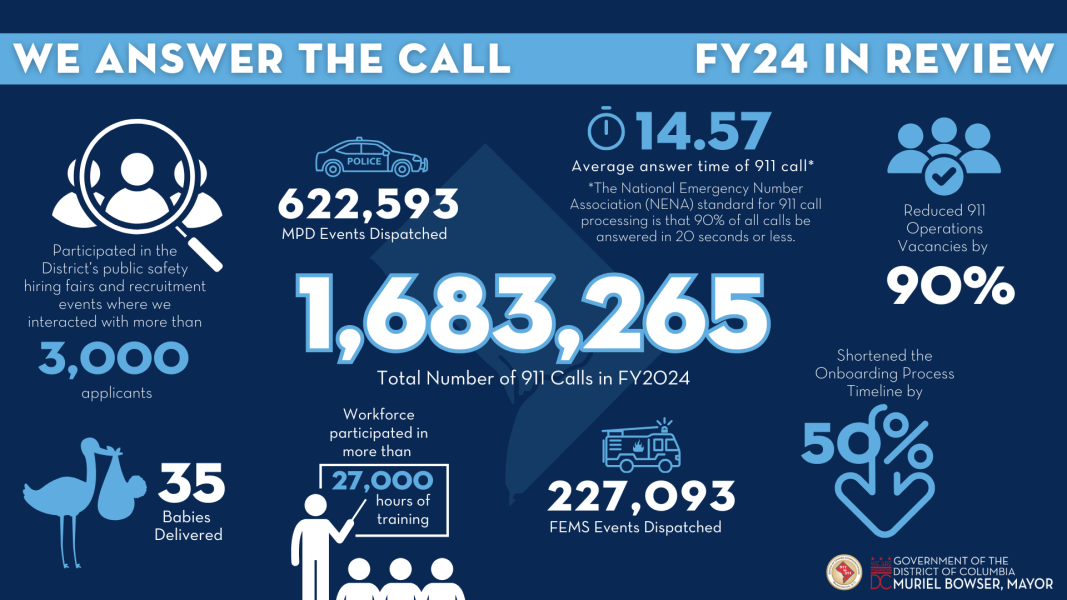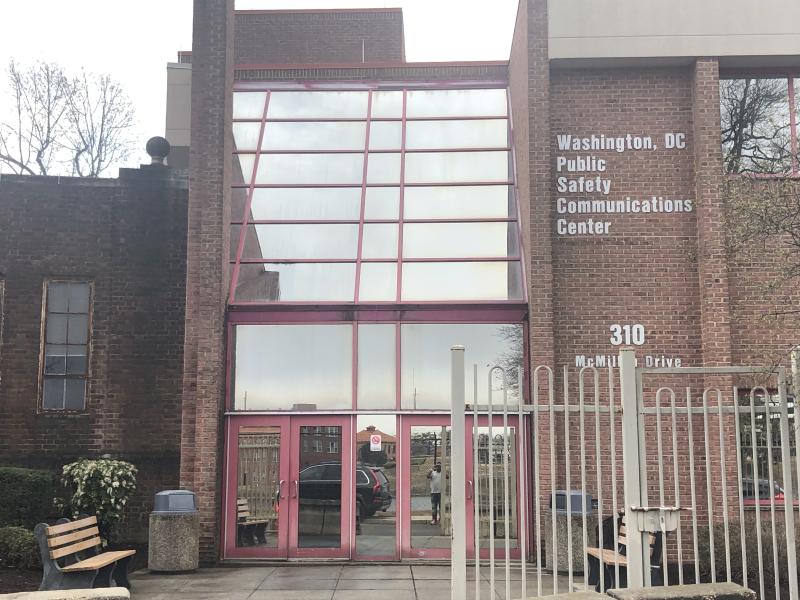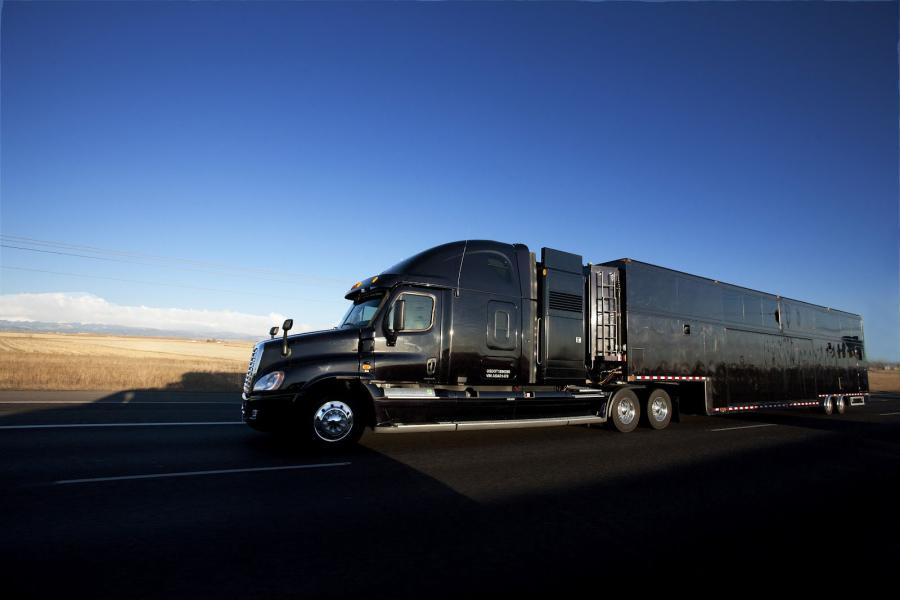The Office of Unified Communications Answers The Call
The Office of Unified Communications serves as the communications lifeline for the nation's capital and the gateway to emergency and non-emergency services in the District - #WeAnswerTheCall
What Does it Mean to Answer The Call?
The mission of the Office of Unified Communications (OUC) is to provide accurate, professional, and expedited service to the residents and visitors of the District of Columbia. Our team serves as the vital link in the District's emergency and non-emergency realm. OUC also provides centralized, District-wide coordination and management of public safety voice radio technology and the public safety wireless communication systems and resources to District government agencies.

Who Answers The Call?
The OUC has a team of nearly 400 employees that work to fulfill the mission of the agency. While the work they do is unseen, telecommunicators are a vital link in the emergency response chain. Our 311 Customer Service Representatives contain encyclopedic knowledge of District services and information. They serve the public every day and help to strengthen the link between constituents and government services.
Meet the OUC Team:
Meet MPD Dispatcher Alita Darby
Meet 911 Call Taker Nicolle Rodriguez
Meet 311 Customer Service Representative Kimara Williams
Meet our executive and senior leaders who support and lead our valued team
Supporting Our Heroes in Headsets: OUC's Executive Team
How Do We Answer The Call?
The agency’s information technology team, led by our Chief Information Officer provides centralized, District-wide coordination and management of public safety voice radio technology and other public safety wireless communication systems and resources to 30 District agencies and federal partners. OUC manages 10 Radio Frequency (RF) sites as well as a high availability network and redundant back up radio system with overlapping RF radio coverage for almost 9,000 radio users including the DC Fire and Emergency Medical Services Department (DC Fire & EMS), Metropolitan Police Department (MPD), Washington Metropolitan Area Transit Authority (WMATA), US Secret Service and other DC and federal partners operating in the District. Our radio system is monitored 24 hours a day, 7 days a week.
311 Systems
The DC 311 telephony system processes over 1.8 million annual calls, including city information and city service requests. The OUC uses a cloud-based, customer relationship management (CRM) application. This application is built on a reliable infrastructure that provides an enhanced experience for the end-user, customer, partner agencies, and Application Programming Interface (API) providers. The 311 application also allows the OUC to push critical upgrades with minimum disruption to operational workflow.
Computer-Aided Dispatch (CAD) and Associated Geographic Information Systems (GIS)
In the late 1990s, DC’s 911 dispatch system was the worst in the country. Since then, we have built a fully redundant E911 network infrastructure and the modernization is 90 percent complete. The National Emergency Number Association (NENA) has identified the District’s network to be a model of how E911 services should be engineered.
The OUC's CAD system is an online, real-time collection of critical services and applications designed to enhance emergency communications center and field operations. The OUC's CAD system typically processes over 800,000 dispatched events annually. These technologies use computerized mapping and analytical features to track and display AVL/GPS-equipped fire and police units and helps dispatchers make recommendations by finding the closest and best-equipped units for any given emergency.
The agency’s emergency dispatch instruction software enables OUC staff to provide 911 callers with lifesaving, pre-arrival instructions over the phone. These instructions can help District callers stabilize and, in some cases, save the lives of people during the vital seconds between the 911 call and emergency response unit arrival.
Where Do We Answer The Call?
The OUC operates three, state-of-the-art communications sites.
|
The July 2001 opening of the Public Safety Communications Center (PSCC) was a critical step in advancing the District's emergency communications strategy. Located in Ward 1 on McMillan Drive, NW, the PSCC greatly improved 911 service for workers and visitors. The PSCC now serves as the secondary site for the OUC and the main site for the agency's Radio Team. The PSCC is currently undergoing renovations. The renovations will upgrade the building's HVAC, electrical, security, fire suppression and external/internal finishes to ensure stabilization of the building systems and reconfigure the space to optimize 911 operations, 311 operations, and training. |
|
On October 1, 2004, management of the PSCC changed from a joint operation of the Metropolitan Police Department (MPD) and DC Fire and Emergency Medical Services Department (DC Fire & EMS) to a new District of Columbia government agency: the Office of Unified Communications (OUC). The agency's responsibilities would include all 911 and 311 call-taking, as well as police, fire, and medical dispatch. In 2006, the District opened the Unified Communications Center (UCC). The UCC is located in Ward 8 on Martin Luther King Jr. Ave SE and serves as the agency's primary location. |
|
T.H.O.R., Tactical Homeland Operations Response, the District's 911 mobile command center, services as the OUC's tertiary site. The two-story, 80-foot-long mobile communications command center is designed to help public safety answering points (PSAPs) maintain operations when their call centers are down or overwhelmed by traffic in crisis situations such as a site evacuation, power outage, or a regional mass casualty event. In the event of a crisis in the District or in the National Capital Region (NCR), T.H.O.R. can full replicate 911 and 311 operations and be used as a full-service PSAP during COOP scenarios. T.H.O.R. is outfitted with 17 dispatch and/or call-taking positions and opening the vehicle's canopy extends the capacity to include 12-14 additional workstations. |




